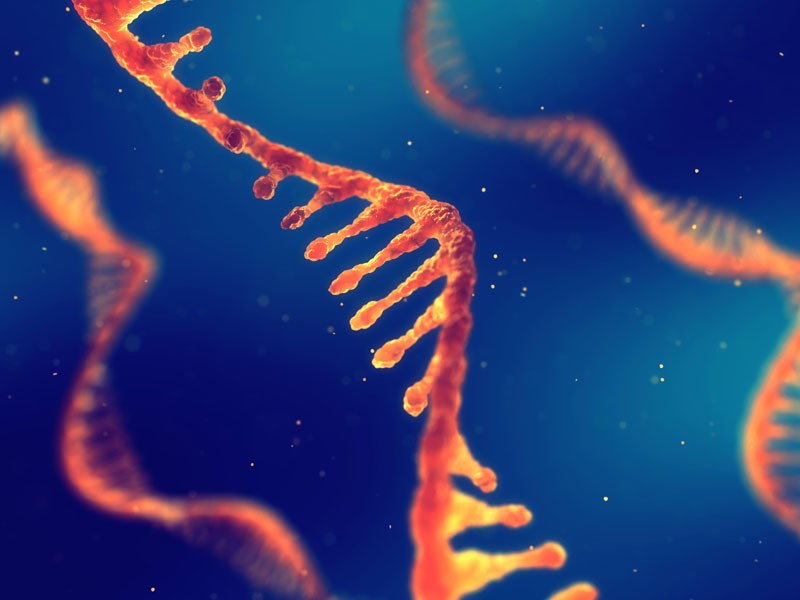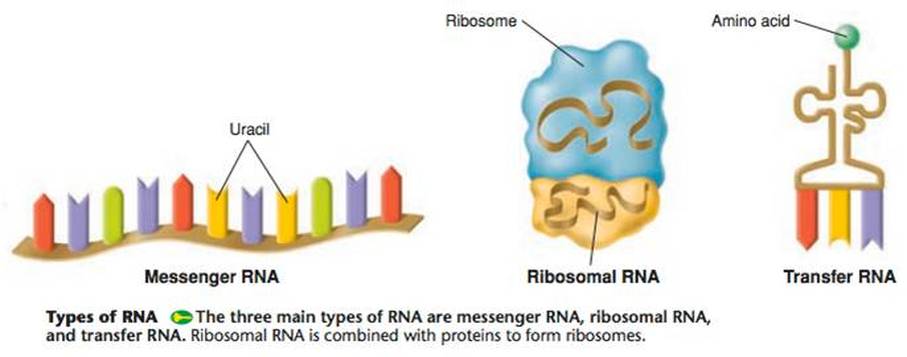
Ribonucleic acid, or RNA, is a form of nucleic acid that plays an important role in cellular protein synthesis and genetic coding.
RNA is similar yet significantly different to DNA.
/dna-versus-rna-608191_sketch_Final-54acdd8f8af04c73817e8811c32905fa.png)
RNA is typically single-stranded, and consists of ribose nucleotides attached by phosphodiester bonds. The nitrogenous bases in RNA are adenine, guanine, cytosine and uracil (which replaces thymine).
RNA is typically shorter and less stable than DNA. Due to the free hydroxyl groups of the ribose sugar, RNA can rabidly degrade, particularly in alkaline conditions. Due to its unique hydrogen bonding, RNA can also form complexes that have intricate interactions, and has both secondary and tertiary structures.
The secondary structure of RNA is mainly composed of a stem structure, formed by complementary base pairing, and a cyclic structure formed by non-pairing.
There are multiple forms of RNA with highly specific functions:
- mRNA (messenger RNA).
- tRNA (transfer RNA)
- rRNA (ribosomal RNA).

mRNA functions in the nucleus and migrates to the ribosome in the cytoplasm. It carries DNA sequence information to ribosomes.
tRNA functions in the cytoplasm. It provides linkage between mRNA and amino acids; transfers amino acids to ribosomes.
rRNA functions in the cytoplasm. It is a structural component of ribosomes.
Both DNA and RNA chains are produced by copying of template DNA strands. These nucleic acid strands grow in the 5′ to 3′ direction. The 5′ end of RNA has a phosphate group attached, and the 3′ carbon has a hydroxyl group.
The transcription of RNA is essential for life. Transcription is the conversion of information from a gene to an mRNA strand. This process is controlled by the operon promoter.
To transcribe a gene, the following are required:
- A promoter.
- A start codon.
- An RNA-coding sequence.
- A DNA non-template strand.
- A terminator.
RNA polymerase is an enzyme that produces RNA and catalyses the initiation and elongation process of RNA transcription chains from a DNA template.
Ribonucleoside triphosphates (rNTPs) are ribose nucleotides bound to three phosphates. They are either ATP, GTP, CTP or UTP.
Sigma factors (often referred to as ‘transcription initiation factors’) are required for the initiation of transcription in bacteria. They enable specific binding of RNA polymerase to gene promoters.
RNA polymerases can initiate strand growth, unlike DNA polymerases, which require a primer. As soon as RNA polymerase binds, RNA can be synthesised. rNTPs act as substrates in this process, and a pyrophosphate is released.
As this process of polymerisation occurs, one phosphate is incorporated into the RNA, and two phosphates are released.
RNA synthesis is complementary and anti-parallel to the DNA template strand. New nucleotides are added from to the 3′ hydroxyl group, from the 5′ to 3′ orientation. The non-template strand of DNA is important for the copying of DNA, in terms of the replication process.
There are three steps in the process of prokaryotic (RNA) transcription:
- Initiation,
- Elongation,
- Termination.